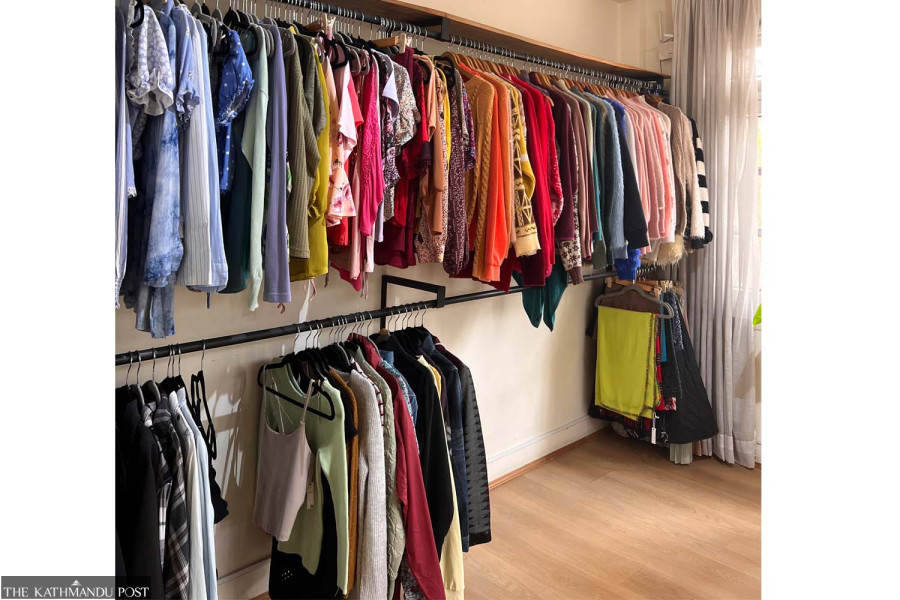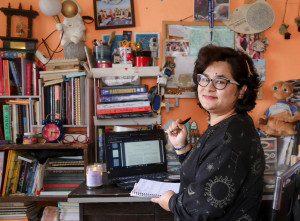Culture & Lifestyle
Scroll, click, thrift
How social media is reshaping the second-hand fashion scene in Nepal, turning pre-loved pieces into a conscious style choice.
Reeva Khanal
Scrolling through social media platforms like TikTok and Instagram, it’s clear that second-hand fashion is no longer just an alternative–it has become a mainstream choice. Thrifting isn’t just saving money; it’s a fashion statement. Social media has transformed thrift shopping into a stylish and sustainable choice.
In recent years, thrifting has experienced a surge in popularity, with social media playing a pivotal role in its revival. It has become a way to promote sustainability, with global fashion trends centring on reusing and recycling materials. Many people have embraced this shift, making second-hand shopping a mainstream choice.
The fashion industry has been transformed by social media, making it more inclusive and allowing diverse personal styles to thrive. Hashtags like ‘ThriftHaul’, ‘SecondhandFashion’, ‘ThriftStoreFinds’, and ‘Pre-loved’ allow users to connect with like-minded individuals, explore thrift stores and appreciate the charm of pre-loved clothing. Thrifting, once seen as an alternative fashion choice, has now become a powerful movement towards sustainability, offering a stylish yet eco-friendly response to the problems caused by fast fashion.
As fashion evolves rapidly, Pooja Moktan, a 22-year-old content creator, advocates for a mindful approach to style that prioritises sustainability over fleeting trends. She has embraced thrift shopping as a budget-friendly choice and a conscious lifestyle decision. “Fashion evolves quickly, but thrift shopping is smarter,” says Moktan. “It lets me find unique, timeless pieces at a fraction of the cost while staying sustainable. This way, I can build a versatile, long-lasting wardrobe without chasing fleeting trends.”
Moktan views second-hand fashion not just as a way to save money but as a way to change how we consume fashion. “I thrift not just for its value but for the sustainability benefits it offers,” she shares. “I take pride in incorporating thrifted pieces into my wardrobe because it allows me to curate a unique collection while fostering a more eco-conscious approach to fashion.”
As a content creator, Moktan raises awareness about thrifting, emphasising its role in promoting mindful financial decisions and curbing overconsumption. She sees a visible shift in the perception of second-hand clothing, especially with public figures like Priyanka Karki and content creators like Razi normalising thrift culture and inspiring others to follow suit.
Similarly, Silvina Pradhan, a 31-year-old entrepreneur, started Dohoran Thrift Studio as an online venture in August 2019. Over the past two years, it has expanded into a physical store. The studio operates on a commission-based model, sourcing clothes directly from customers. Each item undergoes a quality check, laundering, and resale preparation before being displayed. As a consignment store, unsold items are either returned to the seller or offered for donation.

Reflecting on her entrepreneurial journey, Pradhan shares that the post-Covid period has been a roller coaster for business, with both challenges and successes. When asked about current thrifting trends, she noted that since Dohoran operates as a private store, customer engagement fluctuates based on the content they post on their social media platforms and demand for specific items. Her Studio features brands like Zara and H&M. However, there is still a misconception that thrifted items should always be extremely cheap. “People often expect second-hand clothes to cost around Rs500 to Rs600, even for premium brands, which is a challenge,” she says.
Pradhan credits her sister in Sweden for introducing her to second-hand fashion and her cousin for encouraging her to launch the business in Nepal. Witnessing the amount of wasted clothing due to size and taste changes, she realised the need for a sustainable alternative. Pradhan observes that younger customers prioritise affordability, seeking a balance between sustainability and cost. Tops are the best-selling items at her Studio, with branded items and trendy pieces fetching higher resale values. Prices range from Rs100 to Rs15,000 for items like lehengas and sarees.
Despite running the business for five to six years, she emphasises the need to monitor market trends continuously. She believes raising awareness among Nepali consumers is crucial. “Information is powerful, and spreading awareness about thrift culture is essential,” she says. However, people still hesitate to embrace thrifted clothes, leading this culture in need of advertising efforts.
According to Pradhan, investing in a thrift business is challenging due to the lack of market readiness. Unlike retail businesses, where the market already exists, thrift entrepreneurs must create demand before selling, which requires substantial investment, effort, and resources. As a result, many potential investors are reluctant to commit to the sector.
Shashwat Jha, a 23-year-old manager of one of Nepal’s popular thrift stores, Affordable Thrift Store, shares his insights into Nepal’s evolving thrift culture. Having initially handled the store’s sales department, focusing on social media management, he now oversees the entire operation. When asked about the mindset of customers purchasing thrifted clothing, he explained that while affordability is a key factor, fashion plays an even greater role. “If 51 percent is fashion, 49 percent is affordability. Even in thrifting, fashion is taking over the market,” he notes. Many customers opt for thrifted items from premium brands as they offer a more affordable alternative to first-hand products without compromising style.
The store primarily caters to 18 to 35-year-olds, relying on organic marketing through social media and word-of-mouth rather than paid promotions. According to Jha, social media plays a crucial role in thrift shopping, with approximately 70 to 80 percent of sales happening online and only 20 percent in-store. Women’s clothing dominates sales, although men’s and children’s items are also available.
Sirapa Kansakar, a 22-year-old, runs her Instagram-based thrift business (finders.keepers.) since 2020. Reflecting on her journey, she has witnessed Nepal’s growing thrift culture, particularly among younger generations drawn to sustainability and global fashion trends. She believes that we’ll see more curated thrift stores, upcycling trends, and collaborations between thrift shops and high-end local designers in the coming years.
For Kansakar, thrifting isn’t just about affordability—it’s about being mindful of what we buy. She believes content creators are crucial in changing perceptions of second-hand fashion. Rather than promoting large thrift hauls, creators could emphasise styling select pieces in multiple ways and raising awareness about overconsumption. “Content creators should focus on quality over quantity. Instead of massive hauls, they can showcase how to style a few key thrifted pieces in multiple ways,” she says. “Highlighting the environmental impact of overconsumption and encouraging people to buy only what they need can help shift the narrative from excessive shopping to thoughtful fashion choices.”
Social media has made second-hand shopping trendy, shifting the perception from “used clothes” to “vintage finds”. More influencers and thrift store owners are showcasing how stylish second-hand outfits can be, making thrifting feel fresh and exciting. While some stigma still exists—particularly among older generations—Kansakar remains optimistic. “People are slowly starting to see thrifting not as a compromise, but as a cool, conscious choice,” she shares. As more people embrace it, Nepal’s thrift culture is only set to grow.
In Patan, Daisyy Thrift Store is another such store redefining second-hand fashion. Owned by Subekshya Shrestha, 18, the store has grown into a thriving business since she began her online thrifting journey four years ago. She actively posts content on her Instagram page (daisy_thrift), which has helped her gain a significant online following. Shrestha believes social media engagement is crucial in her business, with many customers placing orders directly through Instagram. She sees clothing as more than just something to wear; it is something to appreciate and preserve.
While both sustainability and affordability matter, she sees the latter as the main driving factor behind thrift shopping. “People love experimenting with fashion trends, but buying everything from expensive brands isn’t practical,” she explains.
She highlights the advantages of physical thrift stores over online shopping. “When people visit a store, they can check the quality of clothes before buying and also build better relationships with sellers,” she says. For her, thrifting isn’t just about selling pre-loved clothes; it’s about changing mindsets. She believes sellers should be mindful of how others perceive second-hand items—if people dismiss their value, the cycle of waste continues. Her commitment to preserving and passing on clothing is what drives her business. “If it’s no longer useful to us, it can still be valuable to someone else,” she adds.
Social media has played a key role in popularising thrifting, making it not only accessible but also fashionable. However, challenges remain, such as educating consumers about mindful shopping and the long-term benefits of second-hand fashion. As the market develops, both thrift stores and content creators are expected to play a vital role in shaping the future of fashion in Nepal, promoting creativity, resourcefulness, and conscious consumption.




 15.12°C Kathmandu
15.12°C Kathmandu















